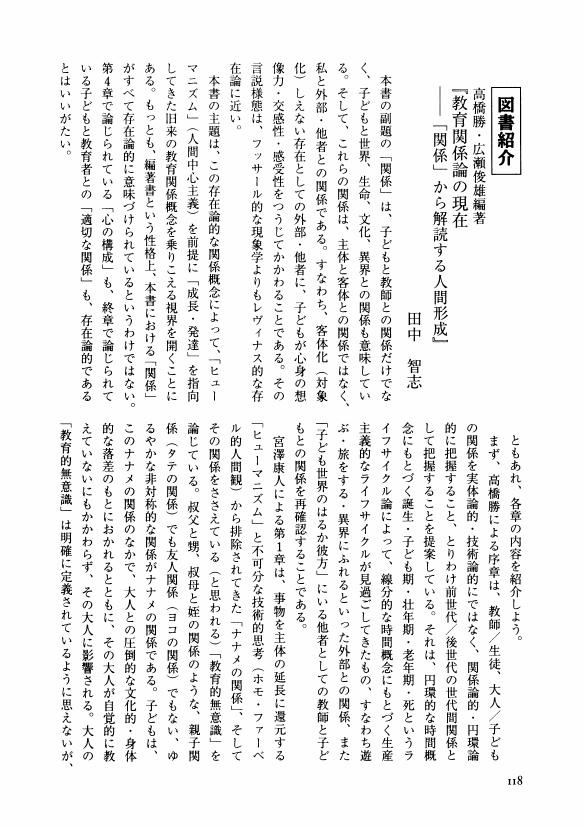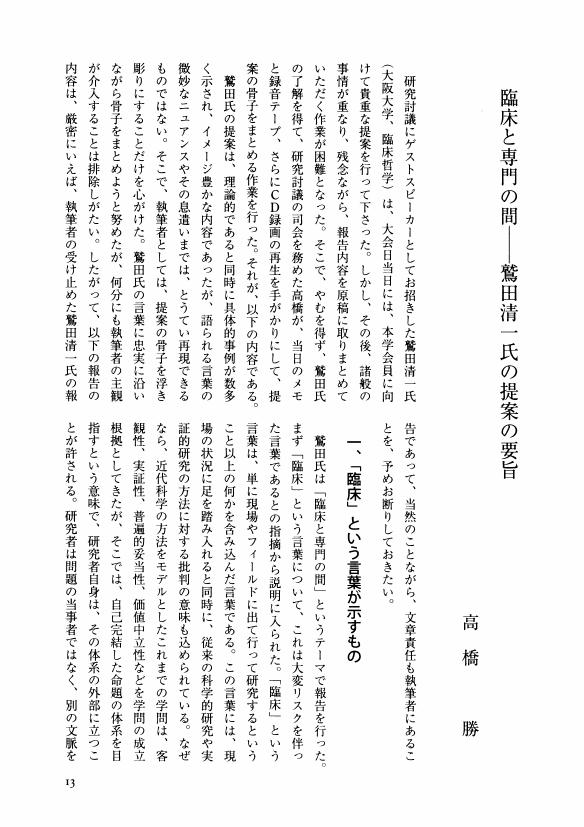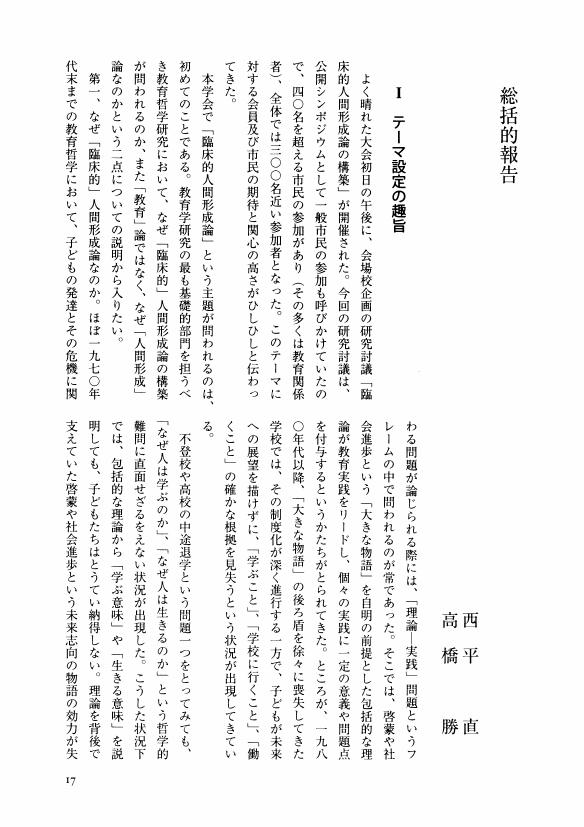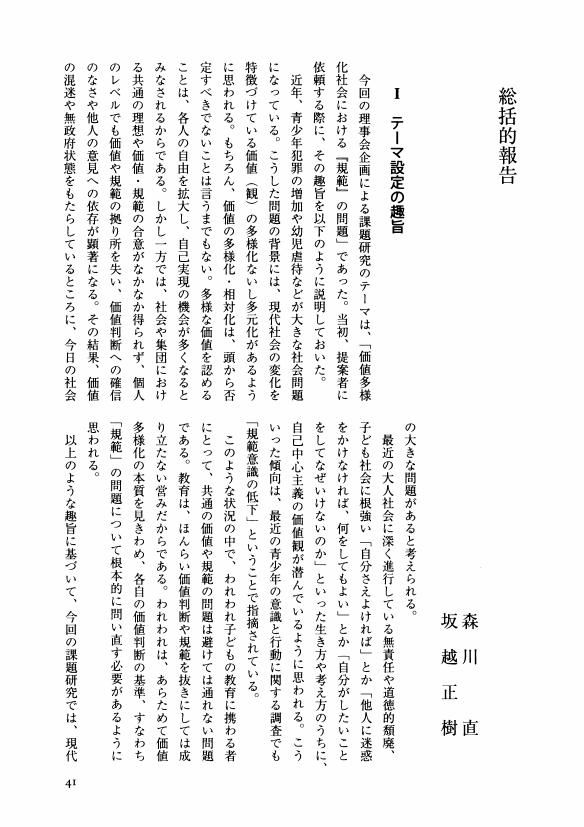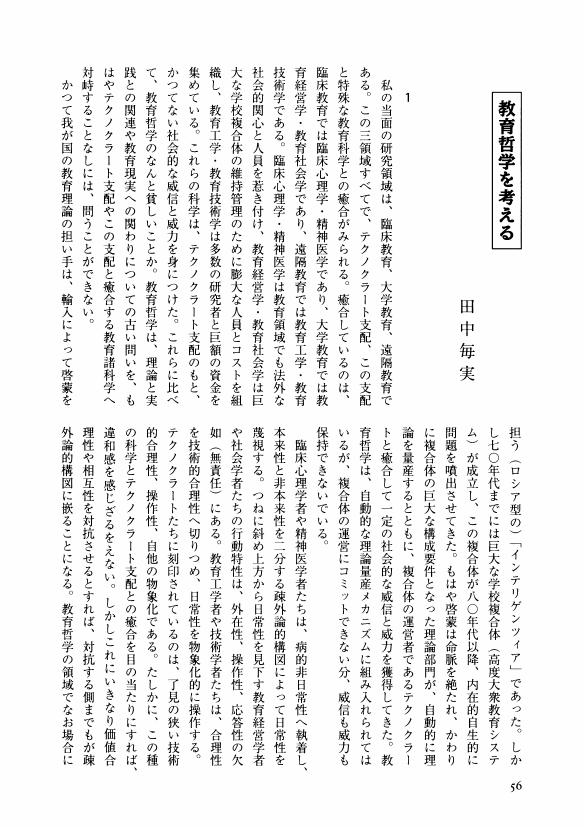1 0 0 0 OA 夢と現のあわいで
- 著者
- 鈴木 晶子
- 出版者
- 教育哲学会
- 雑誌
- 教育哲学研究 (ISSN:03873153)
- 巻号頁・発行日
- vol.2005, no.91, pp.102-103, 2005-05-10 (Released:2009-09-04)
1 0 0 0 OA 稲葉宏雄著『近代日本の教育学 谷本富と小西重直の教育思想』
- 著者
- 木内 陽一
- 出版者
- 教育哲学会
- 雑誌
- 教育哲学研究 (ISSN:03873153)
- 巻号頁・発行日
- vol.2005, no.91, pp.104-110, 2005-05-10 (Released:2009-09-04)
1 0 0 0 OA 松下良平著『道徳の伝達-モダンとポストモダンを超えて』
- 著者
- 林 泰成
- 出版者
- 教育哲学会
- 雑誌
- 教育哲学研究 (ISSN:03873153)
- 巻号頁・発行日
- vol.2005, no.91, pp.111-117, 2005-05-10 (Released:2009-09-04)
1 0 0 0 OA 高橋勝・広瀬俊雄編著『教育関係論の現在-「関係」から解読する人間形成』
- 著者
- 田中 智志
- 出版者
- 教育哲学会
- 雑誌
- 教育哲学研究 (ISSN:03873153)
- 巻号頁・発行日
- vol.2005, no.91, pp.118-120, 2005-05-10 (Released:2009-09-04)
1 0 0 0 OA 徳永正直著『教育的タクト論-実践的教育学の鍵概念』
- 著者
- 福田 弘
- 出版者
- 教育哲学会
- 雑誌
- 教育哲学研究 (ISSN:03873153)
- 巻号頁・発行日
- vol.2005, no.91, pp.121-122, 2005-05-10 (Released:2009-09-04)
1 0 0 0 OA 子どもはどのようにして世界を理解するのか 臨床的アプローチに向けて
- 著者
- 鳥光 美緒子
- 出版者
- 教育哲学会
- 雑誌
- 教育哲学研究 (ISSN:03873153)
- 巻号頁・発行日
- vol.2005, no.91, pp.7-12, 2005-05-10 (Released:2009-09-04)
- 参考文献数
- 14
1 0 0 0 OA 臨床と専門の間-鷲田清一氏の提案の要旨
- 著者
- 高橋 勝
- 出版者
- 教育哲学会
- 雑誌
- 教育哲学研究 (ISSN:03873153)
- 巻号頁・発行日
- vol.2005, no.91, pp.13-16, 2005-05-10 (Released:2009-09-04)
1 0 0 0 OA 総括的報告
- 著者
- 西平 直 高橋 勝
- 出版者
- 教育哲学会
- 雑誌
- 教育哲学研究 (ISSN:03873153)
- 巻号頁・発行日
- vol.2005, no.91, pp.17-22, 2005-05-10 (Released:2009-09-04)
1 0 0 0 OA 規範伝達のルーティンから規範創設の瞬間へ
- 著者
- 土戸 敏彦
- 出版者
- 教育哲学会
- 雑誌
- 教育哲学研究 (ISSN:03873153)
- 巻号頁・発行日
- vol.2005, no.91, pp.29-34, 2005-05-10 (Released:2009-09-04)
- 参考文献数
- 3
1 0 0 0 OA 道徳からの逃走、氾濫する〈規範〉
- 著者
- 松下 良平
- 出版者
- 教育哲学会
- 雑誌
- 教育哲学研究 (ISSN:03873153)
- 巻号頁・発行日
- vol.2005, no.91, pp.35-40, 2005-05-10 (Released:2010-05-07)
- 参考文献数
- 2
1 0 0 0 OA 総括的報告
- 著者
- 森川 直 坂越 正樹
- 出版者
- 教育哲学会
- 雑誌
- 教育哲学研究 (ISSN:03873153)
- 巻号頁・発行日
- vol.2005, no.91, pp.41-46, 2005-05-10 (Released:2009-09-04)
1 0 0 0 OA 教育との連関における気分の哲学的「発見」 M・ハイデガー『存在と時間』以前のパトス解釈
- 著者
- 井谷 信彦
- 出版者
- 教育哲学会
- 雑誌
- 教育哲学研究 (ISSN:03873153)
- 巻号頁・発行日
- vol.2005, no.91, pp.47-65, 2005-05-10 (Released:2009-09-04)
- 参考文献数
- 22
This paper investigates the origin of Heidegger's theory of Pathos prior to his Sein und Zeit. Pathos is a concept generally means moods or sufferings. It has long been considered that moods and sufferings are closely related to education and human development. How is it possible, however, to think about moods and sufferings in connection with education? Heidegger's theory of Pathos gives some valuable suggestions concerning this question.In his earlier thinking, Heidegger already appreciated a close relationship between moods and sufferings, on one hand, as well as our existence, on the other. In his lecture, “Grundbegriffe der aristotelischen Philosophie” (1924), he scrutinized the Greek concept of Pathos. He attempted to reveal those fundamental grounds upon which our understanding of, and speaking about, Pathos become possible. According to Heidegger, the concept has three basic meanings; 1) variable disposition, 2) suffering, 3) passion. In our Dasein, we human beings always have the possibilities of being angry, grieved, or pleased. In these variable moods, we as In-der-Welt-Sein are constantly and inevitably caught by the world and ourselves. Being thus encountered by the world or by ourselves, we are in such movedness (Bewegtheit) as being embarrassed or making up our minds. In this way, we always find the world and ourselves in moods through Logos.In conclusion, the study of the concept of Pathos brings us to those fundamental experiences which enable us to understand and speak about moods and sufferings in connection with education : 1) movedness, 2) passivity, 3) discoveredness (Entdecktheit). The present paper is an initial attempt to find a proper way to think and speak about moods and sufferings.
- 著者
- 柴山 英樹
- 出版者
- 教育哲学会
- 雑誌
- 教育哲学研究 (ISSN:03873153)
- 巻号頁・発行日
- vol.2005, no.91, pp.66-84, 2005-05-10 (Released:2010-05-07)
- 参考文献数
- 44
This paper describes an aspect of Steiner's discourse concerning “Body, ” “Rhythm, ” and “Education.” At first, the author will analyze Steiner's lectures in 1923 on “Muse Education” in ancient Greece, because this concept and his educational practice sustain an important relationship. Steiner envisages the viewpoints of “Rhythmic System” and “Synesthesea” from the antcient Greek idea of the universe. These viewpoints enable him to adopt “Art Education” in his educational practice.Here, the author will compare Steiner's discourse with the thought of Dalcroze, a contemporary philosopher. Dalcroze and Steiner give their thought to the relation of the human body and rhythm, an Aporia for 19th century science. By appropriating the evolutionary theory in the different contexts, both try to explicate the mechanism of the relation between body and rhythm. Each identifies a distinct “Organ of Sense, ” and tries to develop it respectively. But their difference ultimately drives from linguistic definitions. Steiner's “Euryhtmie” consists in the rhythm and gesture which consist in the rhythm and gesture as defined by language.Moreover, the beginning of the 20th century has discovered various “rhythms.” Krieck takes up the rhythm that promoted the moment of festivity as well as human mobilization to community. Dalcorze mentions the rhythm which facilitated human adjustment to the external environment. Steiner points to the inner rhythm of life and to that of words as logos. Although the author has analyzed the same word “Rhythm”, he found its various meanings.The discourse on the connection of “Body, ” “Rhythm, ” and “Education” indicates different possibilities and dangers which may attend various rhythms. Dalcroze notes the power of rhythm which promotes individuals' involvement in the community. By comparison, Steiner emphasizes the transcendental relations between the universe and individuals, and he explores a vision of the rhythm and education distinctly different from that for the formation of community.
1 0 0 0 OA 教育哲学を考える
- 著者
- 田中 毎実
- 出版者
- 教育哲学会
- 雑誌
- 教育哲学研究 (ISSN:03873153)
- 巻号頁・発行日
- vol.2004, no.90, pp.56-57, 2004-11-10 (Released:2009-09-04)
1 0 0 0 OA 田中毎実著『臨床的人間形成論へ-ライフサイクルと相互形成』
- 著者
- 西平 直
- 出版者
- 教育哲学会
- 雑誌
- 教育哲学研究 (ISSN:03873153)
- 巻号頁・発行日
- vol.2004, no.90, pp.58-63, 2004-11-10 (Released:2009-09-04)
1 0 0 0 OA 森田尚人・森田伸子・今井康雄編著『教育と政治-戦後教育史を読みなおす』
- 著者
- 矢野 智司
- 出版者
- 教育哲学会
- 雑誌
- 教育哲学研究 (ISSN:03873153)
- 巻号頁・発行日
- vol.2004, no.90, pp.64-66, 2004-11-10 (Released:2009-09-04)
教育について考え語ろうとする者を、知らぬ間に呪縛し思想と語り方を制限してしまう戦後教育学の物語といったものがある。そのなかの最も強力な物語の一つは、戦後日本の教育史をとらえるときの「権力的に教育政策を聾断する反動的な政治勢力」と「戦後改革の理念を擁護する民主的な革新勢力」とのあいだでの「妥協の余地ない対立抗争」という二元的図式の物語であろう。このような二元的図式の物語にたいして、本書は、戦後教育の果たしてきた社会的機能を、「政策決定のレヴェルからミクロな教室実践にいたるまでの」さまざまな場において展開された「ヘゲモニーをめぐる争いの総和」としてとらえ、戦後教育史を読みなおそうとするものである。本書は以下の三部九章に分かれている。
1 0 0 0 OA 小玉重夫著『シティズンシップの教育思想』
- 著者
- 森田 尚人
- 出版者
- 教育哲学会
- 雑誌
- 教育哲学研究 (ISSN:03873153)
- 巻号頁・発行日
- vol.2004, no.90, pp.67-69, 2004-11-10 (Released:2009-09-04)
1 0 0 0 OA 松田高志著『いのち深く生きる教育』
- 著者
- 岡田 敬司
- 出版者
- 教育哲学会
- 雑誌
- 教育哲学研究 (ISSN:03873153)
- 巻号頁・発行日
- vol.2004, no.90, pp.70-72, 2004-11-10 (Released:2009-09-04)
1 0 0 0 OA 絶句と発語の間 臨床的人間形成論の生成をめぐって
- 著者
- 田中 毎実
- 出版者
- 教育哲学会
- 雑誌
- 教育哲学研究 (ISSN:03873153)
- 巻号頁・発行日
- vol.2005, no.91, pp.1-6, 2005-05-10 (Released:2009-09-04)
- 参考文献数
- 4
- 著者
- 松下 晴彦
- 出版者
- 教育哲学会
- 雑誌
- 教育哲学研究 (ISSN:03873153)
- 巻号頁・発行日
- vol.2004, no.89, pp.165-166, 2004-05-10 (Released:2009-09-04)



